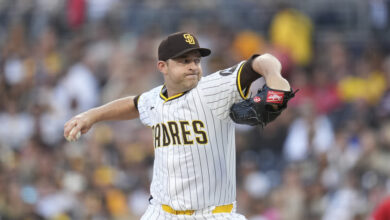
Non-Tendered Relievers Jordan Romano, Kyle Finnegan Could Aid Cubs’ Quest for Bullpen ‘Certainty’
Among the things we know to be true about Jed Hoyer as an executive is that he’s loath to commit big money or multiple years to relievers. Much of that is due to the inherent volatility of bullpen arms, but more may come from the proof of concept he’s established over the last few years. While things took a while to jell in 2024, two of the Cubs’ most successful relief pitchers — Tyson Miller and Jorge López — were acquired as castoffs from other teams. Porter Hodge seemingly came out of nowhere to emerge as the closer and a number of other low-cost guys ate meaningful innings.
The one big expenditure Hoyer made last offseason to help the bullpen was Héctor Neris, and he put together a disastrous campaign that featured five blown saves in 62 appearances. His workload would have been enough to convert a $9 million option for 2025 into a player option, but the Cubs released him in mid-August. As long as that ill-fated deal hasn’t scared Hoyer away from expensive (by his standards) relievers, a pair of them just hit the market via non-tender and may present solid options for building a stronger bullpen.
It’s all about value for Hoyer and the Cubs, which is why I think righties Kyle Finnegan and Jordan Romano could stand out. Not only should they cost less in average annual value than Carlos Estévez and Clay Holmes, but they won’t command multiyear deals they’re both in their final years of arbitration eligibility. Hey, wouldn’t it be funny if the Cubs got a guy named Kyle who was non-tendered by the Nationals? You know, because the Cubs non-tendered a guy named Kyle who went on to sign with the Nationals.
Definitely the first time anyone has mentioned that decision, but I don’t bring it up just to beat a long-dead horse. Rather, it’s a shining example of how not every non-tender is a matter of a team trying to save money on a player whose best days are behind him. Finnegan registered 38 saves for a team that won only 71 games and his 97.2 mph average fastball velocity has held steady for the last three years. That said, he also blew five saves and put up scary batted-ball metrics while also generating mediocre strikeout and walk totals.
MLB Trade Rumors projected Finnegan to earn $8.6 million via arbitration, which is a little steep given the red flags. Perhaps saving a little money on Romano, who was projected at $7.75 million after missing most of the season following arthroscopic surgery to repair an elbow impingement, would be more attractive. I can already see the comments about how Hoyer loves signing pitchers coming off injury, and I can’t really argue with that idea.
Romano still managed to put up eight saves in 15 appearances after totaling 36 in each of the two previous seasons, though he’s also blown 11 chances over those three years. His fastball is slightly less than a tick under Finnegan’s (96.4), but it plays up a little because he gets the most extension in the league from his 6-foot-5 frame. When you release the ball 7.5 feet from the rubber, it really jumps on hitters.
A slider-first pitcher, Romano likes to dot the lower glove-side corner with the breaking ball and then work up to the arm side with his four-seam. Though his walk numbers are only negligibly better than Finnegan’s, Romano’s strikeout rates have consistently been much higher and his batted-ball numbers aren’t nearly as concerning. Even with that elbow issue muddying the waters, I have to say I’d prefer the former Blue Jay if forced to pick between the two.
The Cubs certainly aren’t forced to pick one or the other in this case, and they might sit out the upper-middle relief market entirely in favor of another run at value through volume. But with Hoyer being much more transparent about the need to pay for “certainty” in the bullpen, especially after he hinted at doing so last year, it stands to reason that we’ll see at least one bigger-ticket horse for the arm barn.

